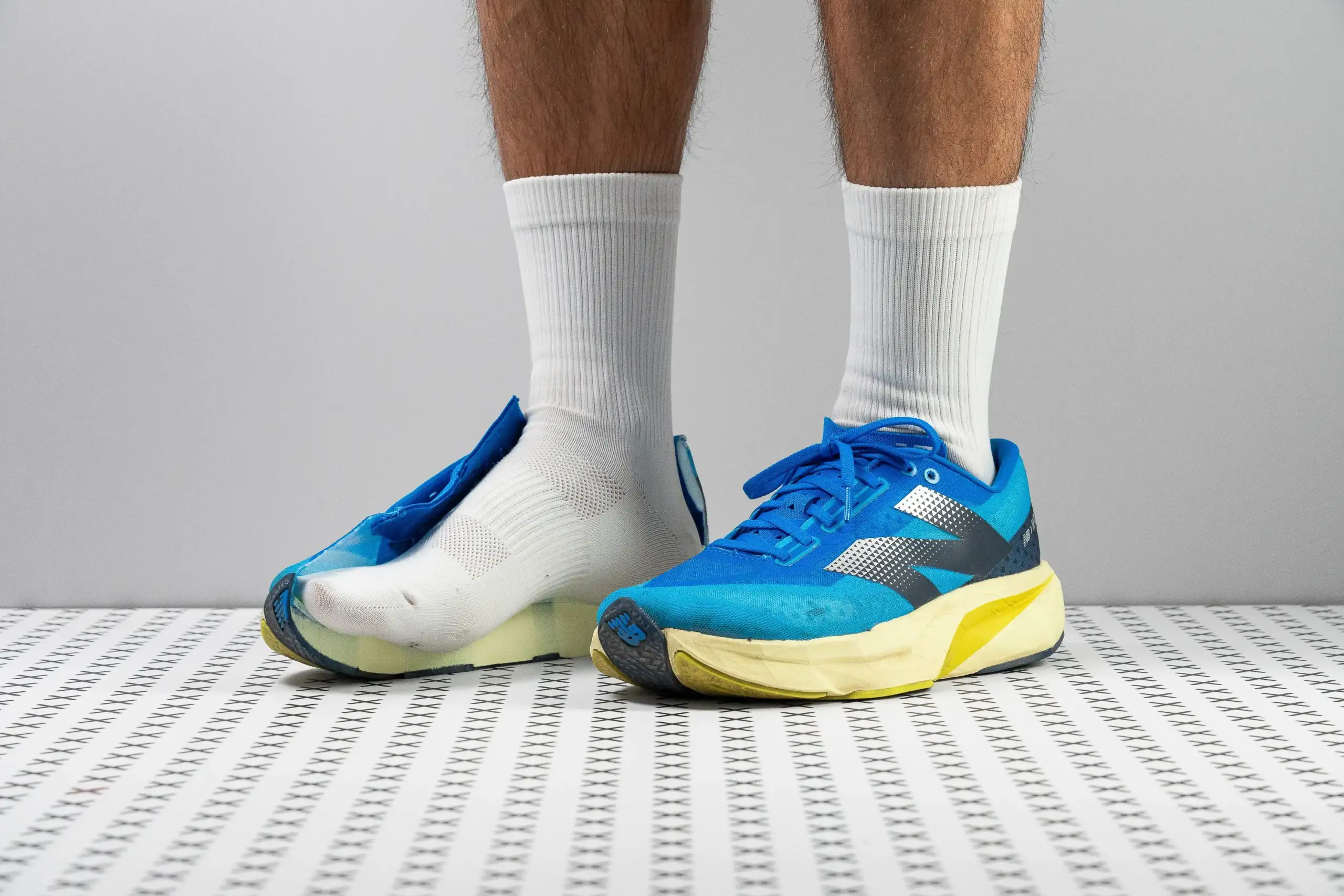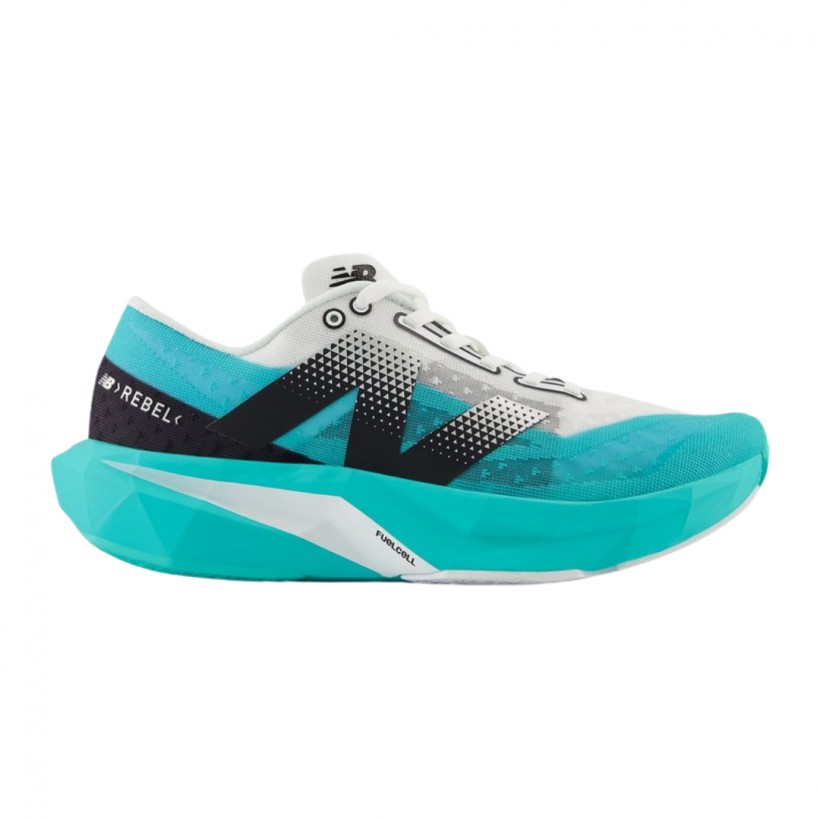The New Balance Rebel V4 delivers amazing performance at $140, which is a big deal as it means that most running shoes cost over $200. This lightweight trainer weighs just 7.5 oz for men and 5.9 oz for women. Despite its featherweight build, it doesn’t cut corners on technology or comfort.
My experience with the New Balance FuelCell Rebel V4 spans over 120 kilometers. This includes a 24-kilometer long run and track workouts at 3:50 min/km pace. The shoe keeps impressing me with its tech upgrades. The FuelCell Rebel V4’s midsole now uses a PEBA-based formula, mixing 20% PEBA with 80% EVA. The stack height boost from earlier versions now reaches 30mm in the heel and 24mm in the forefoot. This improvement gives you better cushioning without losing that responsive feel.
The latest FuelCell Rebel really shines with its super-wide platform – you won’t find many running shoes this wide. This design gives you stability without adding extra weight. The shoe’s shock absorption rating hits an impressive 139 SA in the heel, showing how far the technology has come. The New Balance Rebel V4 proves itself as a versatile performer that excels in both daily training and speedwork, making it one of the most exciting performance trainers you can buy today.

Table of Contents
Who the New Balance Rebel V4 is Best (and Worst) For
The New Balance FuelCell Rebel V4’s adaptability makes it a great pick for runners of all types, though some athletes might not find it matches their running style. Let’s look at who’ll get the most out of this shoe and whether it deserves a spot in your collection.
Ideal runners and training types
Runners who loved earlier Rebel models but wanted more space up top will feel right at home with the V4’s roomier fit. Athletes looking for a light, stable shoe that performs well and won’t break the bank at $140 will find great value here.
This shoe really shines in its ability to handle different types of runs. If you need one shoe that can do it all – from easy runs to race pace – you’ll love how adaptable it is. The Rebel V4 works best for:
- Speed-focused training: The responsive PEBA/EVA blend midsole gives you that peppy feel at any pace, whether you’re doing intervals or tempo runs.
- Race day performance: Runners who don’t want carbon plates will find this shoe perfect for 10Ks and half marathons.
- Marathon training: Many reviewers say it works well for full marathon training, though they’re split on using it for the big day itself.
The shoe’s wider platform and roomy toe box make it a perfect fit for runners with normal to wide feet – you’ll get comfort without losing performance. The wide base adds surprising stability, which means even runners who usually need extra support features can wear these comfortably.
Bigger runners will enjoy the soft but bouncy ride, but should know the shoes might not last as long – possibly around 250 miles. Still, replacing them costs less than buying those pricey carbon-plated alternatives.
Who should avoid the Rebel V4 and why
The Rebel V4 isn’t the right choice for everyone. Runners who want maximum cushioning should look elsewhere since it has a sub-30mm stack height. The ASICS Novablast 5 gives you more protection underfoot at about the same weight and price. If money isn’t an issue and you want the most cushioning possible, check out the ASICS Superblast 2.
Narrow-footed runners should be careful – lab tests show the V4’s wider fit might feel loose. These runners might do better with the older New Balance Rebel V3 or Hoka Mach 5 for a more secure fit.
Some midfoot strikers might struggle with the shoe’s flex pattern. One reviewer puts it simply: “The geometry does not line up with my foot shape or my mechanics”. You might face similar issues if you prefer stiffer shoes or have specific midfoot mechanics.
The Rebel V4 might let down runners who want a dedicated long-run shoe with lots of cushioning and support. While it can handle longer distances, high-mileage runners might want to save it for speed work instead of making it their go-to daily trainer.
Fit, Sizing, and Upper Comfort
The New Balance FuelCell Rebel V4’s sizing creates a puzzle for buyers. Experts don’t quite agree on how this lightweight trainer fits.
True to size or size up?
Runners can’t seem to agree on the FuelCell Rebel V4’s sizing. Most user votes show the shoe runs half size small. Many runners should think about going up a size. Several reviewers suggest picking a half size larger than your usual running shoe size to keep your toes happy.
But some testers say the shoe fits as expected or runs just “slightly short”. One reviewer calls it “just a hair on the small side of being true to size”. Runners between sizes might want to size up to be safe. The upper doesn’t stretch much during use, so those who like a snug fit can stick to their regular size.
Toebox width and height
The FuelCell Rebel V4’s toebox looks quite different from older models. The big toe area has seen a “dramatic transformation”. Measurements show it’s 78.4mm wide – this is a big deal as it means that earlier versions and gives toes plenty of room to spread.
The toebox stands 27.3mm tall, which works well for most foot shapes. The upper won’t stretch much, so runners who need extra height should try it first. Some reviewers say the toe box is “almost reminiscent of the toe box width of the Beacon v3”, showing how roomy it is.
Heel lockdown and tongue design
New Balance aimed to mix security with comfort in the heel design. The Rebel V4 comes with a “lightly padded heel collar” and a “semi-rigid heel counter” that adds structure without bulk. The V3 had more padding, and some reviewers noticed that the “leaner heel collar changes the foot’s position”.
The tongue measures just 2.1mm thick – more like a racing shoe than a daily trainer. Its semi-gusseted design keeps the tongue in place and helps lock down the midfoot. Testers found it comfortable enough for short and medium runs, though they recommend cushioned socks for longer distances.
Breathability and upper material
The Rebel V4 uses New Balance’s lightweight “Fantom Fit” engineered mesh, which feels “soft and seamless” inside. The material breathes really well, and testers loved how it performed “even on warmer days”. See-through mesh areas help with airflow while staying strong.
New Balance fixed the problems from older models. They reinforced the midfoot where the Rebel 2’s mesh used to break down. The new design makes these issues much less likely.
The upper focuses on performance over plushness. It weighs little and lets air flow freely. New users should know that some reviewers found the inside “a little scratchy”, so you might not want to skip socks despite its comfortable build.

Midsole, Cushioning, and Ride Feel
The New Balance FuelCell Rebel V4’s revolutionary midsole technology defines the shoe and changes its performance in running scenarios of all types.
PEBA/EVA foam blend explained
The Rebel V4’s heart features an upgraded FuelCell formulation. Previous versions employed nitrogen-infused EVA and TPU. This version blends 20% PEBA (polyether block amide) with 80% EVA (ethylene-vinyl acetate). The combination gives runners a foam that’s both responsive and durable. New Balance has brought their premium racing shoe’s elements into this more available daily trainer.
The PEBA component—the same material in New Balance’s elite racing models—gives that springy feel runners love. The EVA keeps the shoe’s structural integrity through hundreds of miles. The midsole’s durometer testing shows 15-20 HA, making it super soft compared to other cushioned trainers.
Stack height and drop details
The Rebel V4’s stack height now reaches 30mm in the heel (up from 27mm). This height stays lower than many maximalist shoes available today. The 24mm forefoot creates a 6mm heel-to-toe offset that works great for midfoot strikers.
The midsole’s geometry creates something unique—it sits higher in the midfoot than the heel, confirmed by lab measurements. One testing source points out: “This design may not be ideal for heel strikers, who could sink into the rear of the Rebel”. Midfoot and forefoot strikers often find this setup improves their natural gait.
Energy return and softness
The Rebel V4’s performance numbers shine, especially in energy return. Lab tests show 63.1% energy return in the heel and 66.8% in the forefoot. These numbers put it among the most responsive non-plated trainers you can buy. The heel’s shock absorption at 139 SA shows this model’s technological advancement.
The PEBA component prevents “bottoming out” that earlier versions struggled with, despite its exceptional softness. Heavier runners will find the V4 more suitable. The shoe feels pillowy soft with a slightly firmer underfoot feel than before, hitting that sweet spot between cushioning and responsiveness.
Rocker geometry and transition feel
The Rebel V4 adds a noticeable rocker geometry missing from earlier versions. The curved shape in both heel and forefoot creates a rolling sensation that pushes you forward. The forefoot starts off pretty stiff, as one reviewer mentions: “On day zero, the forefoot is stiff and inflexible”. After 20-30 kilometers of break-in time, the midsole softens up nicely.
The rocker’s effect changes based on your running intensity. Easy paces make the midsole feel bouncy and forgiving. Push harder, and it becomes firmer and more propulsive. A wide base adds stability without losing that dynamic feel lightweight trainer fans look for.
Performance After 100 Miles
The New Balance FuelCell Rebel V4 shows its true colors after proper break-in. Our team put the shoe through its paces with more than 120 kilometers (75+ miles) of running in different workouts to get a clear picture of its performance.
How it handles easy runs
Easy-paced runs in the Rebel V4 yield mixed results. The midsole doesn’t quite shine during slower efforts and feels flatter than your typical daily trainers. Heel strikers might find the unique geometry a bit odd – the midfoot sits higher than the heel, which creates a slight backward rocking feel during recovery runs. Midfoot strikers tend to have a better time with it even at slower speeds.
Tempo and threshold performance
The shoe really comes to life as you pick up the pace. The midsole springs into action with amazing responsiveness once runners hit marathon to 10K effort. The sweet spot consistently shows up between moderate pace and 10K race pace. PEBA-enhanced foam gives you that extra bounce without wobbling, which helps you keep steady-state efforts going strong.
Speed workouts and intervals
The Rebel V4 proves itself as a versatile partner for interval training. The shoe handles serious speed well, even during track workouts at paces up to 3:50 min/km (6:10 min/mile). Of course, its light build (just 7.5 oz) helps a lot with shorter, faster efforts.
The shoe does have its limits though. The softer midsole compresses too much during all-out 200-400m repeats, which makes it less snappy than you’d want for pure sprint work. This becomes even more obvious on steep uphills.
Comparison to plated shoes
The Rebel V4 feels quite different from carbon-plated racing shoes. While carbon models give you better propulsion at threshold paces, the Rebel V4 works great as a training shoe. Runners need to work a bit harder in the Rebel V4 to keep the same threshold pace compared to plated options.
This extra effort turns out to be a good thing for training. Your legs have to work harder without a plate, which could mean stronger muscles by race day. Many coaches have a simple formula – train in the Rebel V4, race in carbon-plated shoes to get the best results.
Durability, Traction, and Stability
The New Balance FuelCell Rebel V4 combines lasting reliability with outstanding performance. Smart design choices boost its durability without compromising the light feel runners love.
Outsole wear and rubber coverage
The Rebel V4’s rubber placement is strategic rather than complete to save weight while lasting longer. Lab tests show a solid 0.8mm indentation after durability testing, and the outsole is a robust 3.2mm thick. Runners barely notice any wear even after putting in serious miles. One tester shared “after 120 kilometers the outsole looks almost the same as the day I got the shoe”. The exposed midsole foam shows expected scuffs around 30 miles. Many users run 200-300 miles before seeing any real wear.
Upper and heel padding durability
The Fantom Fit upper is much better than earlier versions. It fixes the separation problems that affected the V2 model at the 400km mark. The heel padding’s perfect 5/5 durability score points to excellent longevity. The upper might look thin, but it stays strong through heavy use.
Stability from wider platform
The biggest upgrade is the shoe’s wider base. The midsole width jumped from 110.3mm in the V3 to 124.7mm. One reviewer called it “probably the widest of all my running shoes”. This bigger footprint changes the Rebel V4 into a stable neutral shoe. Even runners who usually need extra support features can wear it comfortably.
Grip on wet and dry surfaces
The shoe grips better than expected in all conditions. Its 0.50 friction score in the SATRA TM144 grip test proves it works well on both wet and dry surfaces. Testers found “absolutely no issues with traction despite the lack of total rubber coverage”, even in heavy rain. The shoe handles sharp turns on wet roads while you retain control.
Summing all up
The New Balance Rebel V4 represents a breakthrough in running shoe design. This lightweight trainer delivers performance that rivals more expensive shoes at just $140. The Rebel V4 shines with its innovative PEBA/EVA blend midsole that provides exceptional energy return and impressive durability, though it might not suit every runner perfectly.
The shoe still impresses with minimal wear signs after 100+ miles of testing in conditions of all types. A wider platform revolutionizes the stability profile without adding weight, making this version available to more runners than its predecessors. On top of that, it addresses fit issues from previous models with a roomier upper, though runners with narrow feet might find the lockdown less secure.
The Rebel V4’s versatility makes it stand out. The shoe excels during tempo runs and threshold workouts, showing its best qualities at faster paces. Midfoot strikers will find more consistent experiences at all paces compared to heel strikers, who might feel that slight backward rocking sensation during slower efforts.
Many runners could benefit from training in the Rebel V4 and racing in plated shoes, even without a carbon plate. This combination helps build stronger legs on race day because of the greater muscle engagement required. The strategic rubber placement creates an ideal balance between weight and longevity, resulting in an outsole that grips well in both wet and dry conditions.
Runners looking for a lightweight, responsive, and versatile training shoe at a reasonable price should think over the New Balance Rebel V4. Very few shoes today offer similar performance at this price point, especially with the upgraded PEBA-infused midsole technology. The Rebel V4 has earned its spot as one of the most exciting performance trainers on the market, delivering exceptional value with every mile.
Here are some FAQs about the New Balance Rebel V4:
What is the new Balance Rebel v4 for?
The new balance rebel v4 is designed as a lightweight, responsive training shoe ideal for tempo runs and speed workouts. Featuring FuelCell foam technology, the new balance fuelcell rebel v4 provides explosive energy return for faster-paced sessions. Many runners use the rebel v4 new balance for interval training, 5K-10K races, and as a complement to their daily trainers.
Is Rebel v4 good for marathons?
While the new balance fuel cell rebel v4 offers excellent responsiveness, its minimal stability and moderate cushioning make it better suited for shorter races. Some elite runners might use the new balance rebel v4 for marathons, but most would prefer more cushioned options for 26.2 miles. The rebel v4 new balance shines best at half-marathon distance and below.
When did NB More v4 come out?
The New Balance Fresh Foam More v4 (a different model from the rebel v4 new balance) was released in early 2023. Meanwhile, the new balance fuelcell rebel v4 launched later that same year as part of their performance running lineup. Both the More v4 and rebel v4 new balance represent 2023 updates to their respective series.
Is the New Balance Rebel v4 good for wide feet?
The new balance rebel v4 is available in wide widths, making it accommodating for runners with broader feet. Reviews of the new balance fuelcell rebel v4 review note the standard width runs slightly narrow, so wide-footed runners should consider the specific wide version. The rebel v4 new balance offers a secure midfoot wrap that works well when sized appropriately.
Are the Rebel v4 good?
Absolutely, the new balance fuel cell rebel v4 receives strong praise as one of the best lightweight performance trainers on the market. According to new balance fuelcell rebel v4 review analyses, it offers an exceptional balance of responsiveness, comfort, and versatility. The rebel v4 new balance is particularly favored by runners who want a fast-feeling shoe that still provides decent protection.
Is the Rebel v4 a daily trainer?
While the new balance rebel v4 can handle daily miles, it’s primarily optimized for faster-paced runs rather than high-volume easy days. The new balance fuelcell rebel v4 review community suggests pairing it with a more cushioned shoe for full training cycles. The rebel v4 new balance works best as a speed day complement to traditional daily trainers.
What is the most stable marathon shoe?
While the new balance fuel cell rebel v4 excels at speed, the most stable marathon shoes are typically models like the New Balance 860 or Brooks Adrenaline GTS. These differ from the rebel v4 new balance by offering structured support for overpronation. For marathoners needing stability, motion-control options provide more protection than the neutral-focused new balance rebel v4.


